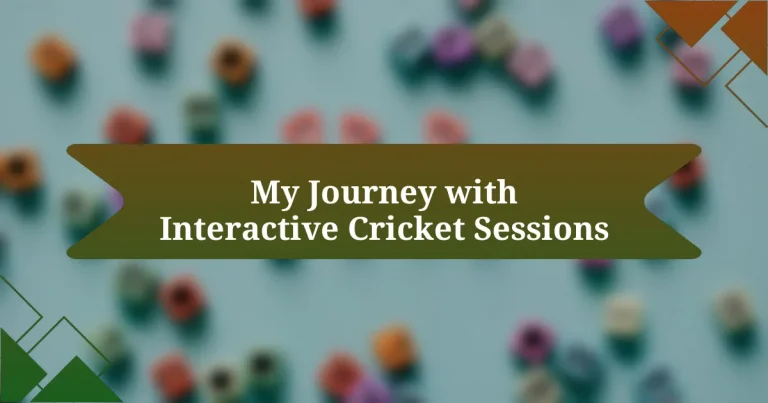Key takeaways:
- Interactive cricket sessions foster teamwork, communication, and leadership skills among young players.
- Mastering fundamental skills such as batting, bowling, and fielding boosts confidence in young cricketers.
- Creating a positive and enjoyable learning environment encourages children to engage with the sport and develop a lasting love for cricket.
Introduction to Cricket for Kids
Cricket is more than just a sport; it’s a vibrant, fun-filled activity that sparks joy in kids. I remember the first time I introduced my child to the game, watching their eyes light up as they grasped the shiny bat and ran onto the field. Doesn’t that sense of excitement make you want to share the experience with your children?
There’s a beautiful blend of teamwork, strategy, and physical activity in cricket that resonates with young players. I often see kids developing lifelong friendships as they learn to work together and celebrate both victories and defeats. Have you noticed how much they grow in confidence as they master new skills?
The beauty of cricket lies in its ability to cater to players of all ages and skill levels. When I see beginners playing alongside seasoned players, it warms my heart. It raises the question: what better way to cultivate a love for the game than through interactive sessions that encourage participation and fun?
Benefits of Interactive Cricket Sessions
Interactive cricket sessions offer numerous benefits that can profoundly impact kids. Through these engaging formats, I’ve seen young players develop not just cricket skills, but also valuable life skills like communication and leadership. Have you ever noticed how a child might initially be shy but, in the right environment, blossoms into a confident team player?
What I love most about interactive sessions is how they turn learning into play. I recall a particular day when my child was struggling to get their stance right, but after playing some fun target games tailored around batting, they suddenly hit the ball with newfound enthusiasm. It’s incredible how play can break down barriers and create moments of achievement that encourage kids to keep pushing themselves.
Moreover, these sessions foster a sense of community and belonging among participants. During one practice, I observed how kids from different backgrounds came together, sharing laughter and stories. Doesn’t it warm your heart to see them form connections while developing their passion for cricket? It reinforces the idea that cricket is not just about the game but about the friendships and memories they create along the way.
Essential Skills for Young Cricketers
When it comes to essential skills for young cricketers, mastering the basics of batting, bowling, and fielding is crucial. During my own journey, I noticed that when kids focus on their grip and stance while batting, their confidence at the crease skyrockets. Isn’t it fascinating how the right foundation can lead to incredible improvements in performance?
Another important aspect is hand-eye coordination. I remember watching a young player who struggled with catching; after incorporating fun drills into our sessions, their improvement was remarkable. Seeing the sheer joy on their face when they finally snared a high catch was a moment I will never forget. It makes you realize how small victories can fuel passion and commitment in budding players.
Lastly, teamwork cannot be overlooked. Cricket is inherently a team sport, and I’ve seen firsthand how kids learn to communicate and support each other on the field. There was this one match where a child encouraged a nervous teammate before a big bowl; the unity they built was palpable and heartening. Isn’t that what makes cricket a beautiful game?
How to Organize Cricket Sessions
Organizing cricket sessions can be an exciting yet challenging task. I often start by setting clear objectives for each session, ensuring that we focus on skill development while keeping it enjoyable. For example, I once aimed to teach bowling techniques, but found that including a mini-game format not only made it more engaging but also reinforced what they were learning. Isn’t it amazing how a little creativity can transform a mundane practice into a fun learning experience?
Next, I prioritize the layout of the practice area. I remember when I was running drills for catching; I positioned cones to create a designated space for each activity. This not only kept the kids focused but also allowed for a flow between each drill, minimizing downtime. Observing their excitement as they moved from one skill to another was incredibly rewarding. Have you ever seen a child’s confidence soar when they accomplish something they didn’t think they could do?
Lastly, don’t underestimate the value of feedback. After each session, I like to gather the kids together and talk about what went well and what we can improve on. I recall one session where we discussed their favorite drill, and it turned into a lively conversation about how they could incorporate similar techniques during matches. Creating an environment where they feel comfortable sharing their thoughts can enhance their engagement and growth. How many times have you left a session feeling like everyone is on the same page? It’s an essential part of fostering a positive cricketing culture.
My First Experience with Cricket
My first experience with cricket was a whirlwind of excitement and nerves. I remember stepping onto the field for the very first time, feeling the sun on my back and the weight of the bat in my hands. That day, I was introduced not just to the game but to the camaraderie that comes with it—a bond that I still cherish today.
As I stood at the crease, my heart raced every time the bowler approached. I felt a mix of fear and thrill, especially when I connected with the ball for the first time. It was a moment of pure joy; I could hardly believe I had done it! Has there ever been a feeling so exhilarating as seeing your hard work pay off in such a tangible way?
Reflecting on that day, I realize it wasn’t just about hitting the ball; it was about the sense of belonging I found in the team. The cheers from my teammates made me feel like a star, even though I was a beginner. That experience ignited my passion for cricket and taught me that every journey—no matter how daunting—can lead to unforgettable moments and lifelong friendships. What was your first cricket memory?
Key Lessons from Interactive Sessions
Engaging in interactive cricket sessions opened my eyes to the importance of teamwork. During one session, I vividly recall a moment when my teammates and I had to strategize on the field. It was fascinating to see how our individual strengths complemented each other, making me realize that communicating effectively not only leads to better gameplay but also strengthens the friendships formed along the way. Have you ever experienced a time when teamwork just clicked for you?
Another key lesson from these sessions was the value of patience. There were times when I found myself struggling to keep up with the pace of the game. Yet, in those moments, I learned that taking a step back and observing the play around me often led to finding new ways to improve my skills. It was a reminder that growth in any sport, including cricket, takes time and consistent effort. Can you remember a situation when patience really paid off for you?
Lastly, I discovered that embracing failure is essential. I remember missing an easy catch during a practice session, and instead of feeling defeated, I was encouraged by my coach to learn from it. That incident taught me that mistakes are simply stepping stones on the path to mastery. By reframing my perspective, I began to see failures as opportunities for growth, something I now cherish in all aspects of life. Does it resonate with you when I say that each setback can teach us something valuable?
Encouraging Kids to Enjoy Cricket
Encouraging kids to enjoy cricket goes beyond just teaching them the rules of the game. I remember introducing a group of children to cricket by organizing fun mini-matches, where the emphasis was on laughter rather than competition. Their initial hesitance quickly transformed into excitement, and before long, they were cheering for each other as if they were seasoned players. Don’t you agree that when kids experience joy in learning, it creates a lasting impression?
Creating a positive atmosphere is also crucial in fostering a love for cricket. One time, after a particularly challenging practice, I noticed a kid feeling disheartened about not being able to hit the ball well. Instead of focusing on his mistakes, I shared my own early experiences of struggle and encouraged him to celebrate small achievements, like simply connecting with the ball. Do you remember a moment when someone helped you see your potential, even when you felt stuck?
Another effective way to instill passion is by incorporating games that teach cricket concepts. I once played a modified version of cricket with colorful foam balls and smaller bats, targeting a younger audience. Watching their faces light up with every successful hit showed me that creativity can transform learning. Have you seen how playful approaches can ignite enthusiasm and bring kids together?



